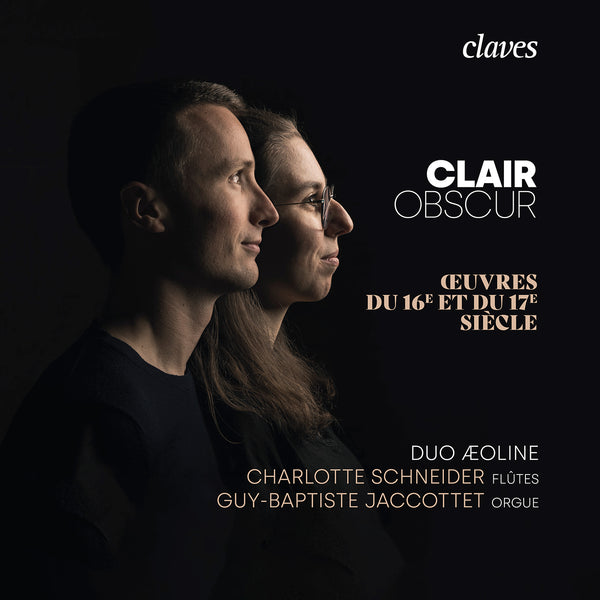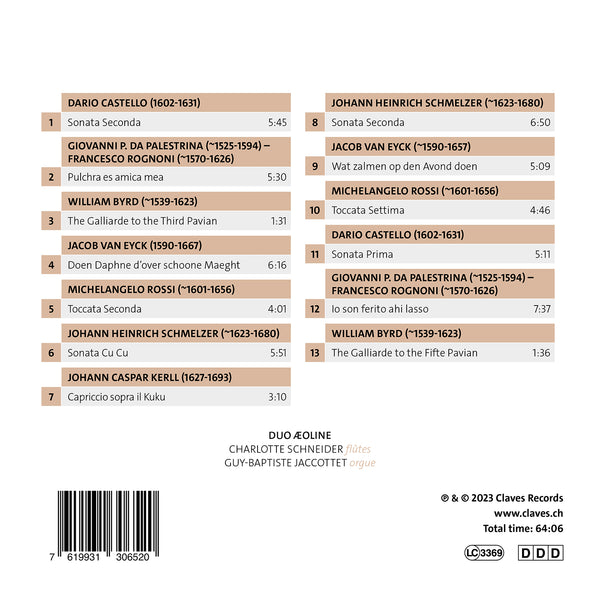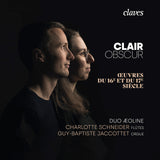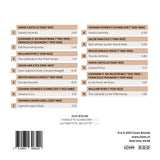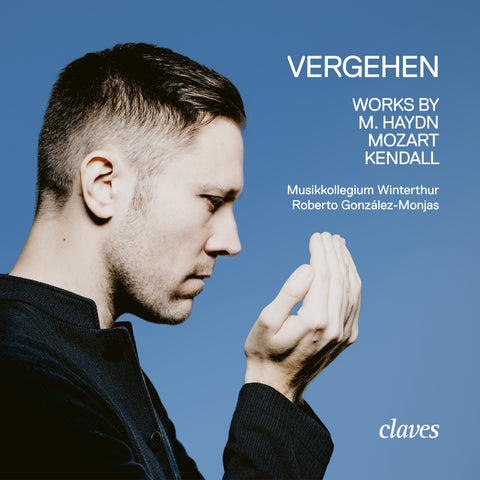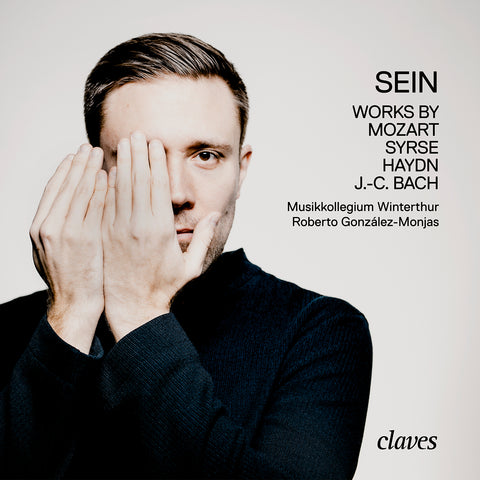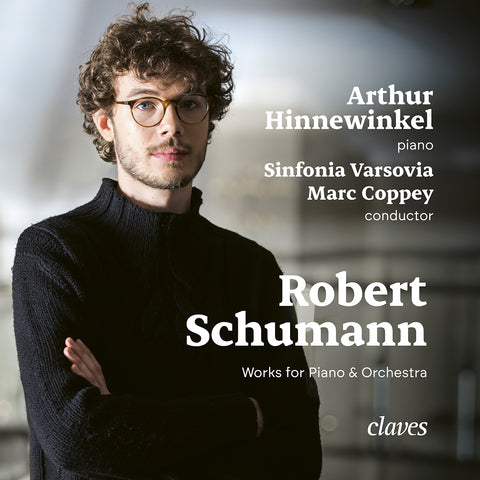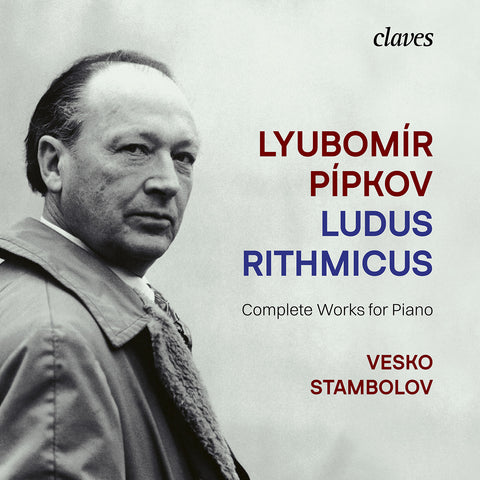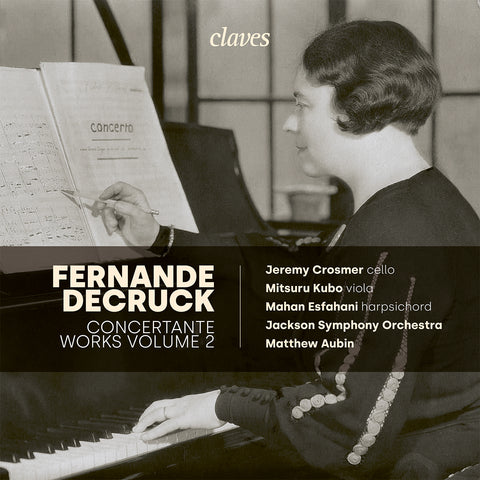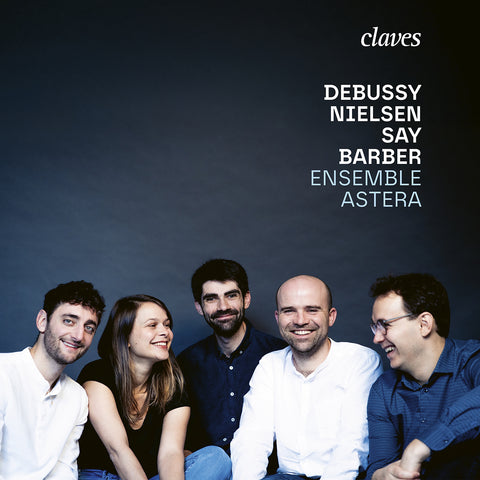(2023) Clair Obscur: Oeuvres du 16e et du 17e siècle pour flûte et orgue
Category(ies): Ancient music Rarities
Instrument(s): Flute Organ
Main Composer: Various composers (see collections)
CD set: 1
Catalog N°:
CD 3065
Release: 30.06.2023
EAN/UPC: 7619931306520
This album is now on repressing. Pre-order it at a special price now.
CHF 18.50
This album is no longer available on CD.
This album has not been released yet. Pre-order it from now.
CHF 18.50
This album is no longer available on CD.
CHF 18.50
VAT included for Switzerland & UE
Free shipping
This album is no longer available on CD.
VAT included for Switzerland & UE
Free shipping
This album is now on repressing. Pre-order it at a special price now.
CHF 18.50
This album is no longer available on CD.
This album has not been released yet.
Pre-order it at a special price now.
CHF 18.50
This album is no longer available on CD.
CHF 18.50
This album is no longer available on CD.
CLAIR OBSCUR: OEUVRES DU 16E ET DU 17E SIÈCLE POUR FLÛTE ET ORGUE
CLAIROBSCUR
Duo Æoline
Charlotte Schneider and Guy-Baptiste Jaccottet have been exploring since 2017 the multiple sounds offered by their combined instruments. These curious and playful musicians explore a repertoire stretching from the 16th to the 18th century, transcribing and arranging pieces for their duo. As a result, their music lies at the crossroads of historically informed performance practice and the concrete reality of instruments and places.
guyjaccottet.com / schneidercharlotte.com
Introduction
Love at first sight for the building, the history, the acoustics and the outstanding organ of the Payerne Abbey: following a first concert programme in 2021, the desire to record in this magnificent setting immediately became obvious.
The abbey’s Ahrend organ – a true musical jewel in the centre of this Romanesque masterpiece – is the programme’s cornerstone. The different pieces have been chosen to highlight the instrument’s multiple facets, from the depth and serenity of the Principal to the elegant clarity of the Ripieno. The immense richness of its meantone temperament with split sharps and its keyboard descending to F (12’) allow the performer to make the most of a huge palette of sound and harmonic colours.
Apart from the solo works, each piece is arranged to suit the specificities of the different flutes and the organ. In the sonatas, for example, specific passages had to be octavated or rewritten for the recorder, and the continuo was arranged so that the whole instrument could be heard. The gaillardes written for solo keyboard have been set for organ and flute, and Palestrina’s madrigals are broadly performed on the keyboard to avoid certain voice crossings that the organ cannot render correctly.
This constant arrangement and transcription process is part of our work as a duo. We endeavour to remain as faithful as possible to the text while considering the needs of our instruments at an individual and joint level.
In this duo programme, the works are played in pairs.
Works
Dario Castello, Sonata Seconda & Sonata prima
Dario Castello’s two sonatas for violin and bass are commonly played on the recorder. Although a few passages are outside the recorder’s range and require small arrangements, the bulk of the piece can be perfectly played on this instrument. These sonatas rich in emotions project us directly into a world of contrasts, from an exalted virtuosity to the moving intimacy of a few bars. They perfectly represent the transition to the beginning of the Baroque era.
Giovanni Pierluigi da Palestrina / Francesco Rognoni, Pulchra es amica mea & Io son ferito ahi lasso
These diminutions plunge us directly into the very end of the Renaissance. The virtuosity and boldness of Rognoni’s ornaments overlap the eloquent counterpoint of two Palestrina madrigals. The encounter of these two generations opens up an immense dynamic range. The traverso’s flexibility melts into the organ’s gravity. Rognoni adorns the upper voice (cantus) in a particularly virtuoso manner, without assigning these diminutions to a specific instrument. The organ, for its part, takes up the five voices of Palestrina’s original madrigal, including the cantus, and thus doubles the traverso without its ornaments.
William Byrd, The Galliarde to the Third Pavian & The Galliarde to the Fifte Pavian
The two galliardes are taken from My Lady Newells Booke, a keyboard collection composed by William Byrd. Although these pieces were initially intended to be played after a pavane, they are taken here out of their context and rewritten for organ and recorder. Perfectly English and in a different style from the pre-Baroque sonatas, these short dances set a brighter tone and enable other facets of each instrument to be highlighted.
Jacob Van Eyck, Wat zalmen op den Avond doen [What shall we do this evening?] & Doen Daphne d’over schoone Maeght [When Daphne, the most beautiful maid]
These two suites of variations, composed by the famous Dutch flautist, organist and carillonneur Jacob Van Eyck, are excerpts from his book Der Fluyten-Lusthof (The Garden of Flute Pleasures). In this collection, the composer developed variations on popular and religious tunes from different countries.
The theme of Daphne is reflective and introverted, yet it allows a touch of madness to creep into the development of its diminutions.
The tune Wat zalmen, on the other hand, presents a lightness and carelessness that becomes cheeky and mischievous in the various games of binary and ternary rhythms.
The choice of recorders used for these pieces is motivated by the generous acoustics of the venue and the search for lower, more intimate sounds, especially with the tenor recorder.
Michelangelo Rossi, Toccata Seconda & Toccata Settima
The Toccatas by Michelangelo Rossi, known as Michel Angelo del Violino, indeed count among the most extraordinary works (in the primary sense of the term) in the pre-Baroque keyboard repertoire. The incredible freedom of his language and the sometimes very violinistic turnings of his writing give his toccatas a unique identity and energy.
The Toccata Seconda and Toccata Settima are among those that sound at their best on the organ. The association of these works with the instrument of the Payerne Abbey – inspired by the organ of the Basilica of San Petronio in Bologna – seemed an obvious choice. They illustrate the multiple sound combinations offered by the Payerne organ’s 11 registers. The pieces are inspired by Vincenzo Colombo’s manuscript, which lists all the possible stop combinations for the organ he built in Valvasone in 1532.
Rossi echoes Castello here, rushing the listener from one feeling to another with a great deal of virtuosity and harmonic twists, ranging between joy, doubt and enthusiasm.
Johann Heinrich Schmelzer, Sonata Cu Cu & Sonata Seconda
Johann Heinrich Schmelzer dedicates his sonatas to the violin. While the facsimile of the Sonata Seconda is easily accessible and readable, the same cannot be said for the Sonata Cu Cu. Indeed, the various editions available contain several inconsistencies, probably due to copying errors. A microfilm from the Schola Cantorum Basiliensis library provided us with a period manuscript – probably the only one currently available. Therefore, we have explored various possibilities for correcting these passages to offer a coherent and respectful version with this recording.
We also tried out different types of recorders before deciding on this atypical sopranino by transposing the sonata a fourth above the original key.
Johann Caspar Kerll, Capriccio sopra il Kuku
Compared to Schmelzer’s Sonata Cucu, the Capriccio sopra il Kuku features the delightful Flauto in ottava on the Ahrend organ. This alone fills the Abbey Church with multiple echoes, joyfully setting the whole building in resonance. Schmelzer and Kerll both found themselves at the Emperor’s Court in Vienna, and one can bet that they heard each other’s music. In any case, the following decades perpetuated this game and gave rise to numerous musical aviaries and zoo pieces of all kinds throughout Europe.
Translated from the French by Michelle Bulloch - MUSITEXT
Guy-Baptiste Jaccottet, organ
Fascinated by organ in all its ways of expression, Guy-Baptiste Jaccottet (1998) studies repertoire in the class of Benjamin Righetti (HEMU-Lausanne) and improvisation in the class of Paul Goussot (CRR Rueil-Malmaison). Deeply attracted to improvisation, theater and cinema, he is titular organist at the Théâtre Barnabé. From 2019 to 2021, he is assistant organist at the Saint-François Church in Lausanne. In 2020, he took up his duties as titular organist at the Temple de La Tour-de-Peilz and as organ teacher at the Conservatoire de Montreux-Vevey-Riviera.
As a concert organist, a cinema organist or in chamber music, he gives about thirty concerts a year, notably in prestigious places (Verbier Festival, Festival internazionale di musica organistica di Magadino, Festival l’orgue fait son cinéma Geneva, Festival Bach de Lausanne, Davos Festival). Always keen to defend a wide and varied repertoire, he regularly produces videos on his YouTube channel. His music was also recognized in 2016 with the First Prize and the Audience Prize of the international composition competition Musique Nouvelle pour Flûte-à-bec as well as the publication of his pedagogical works by the association Kinder an die Orgel (2022 release).
Eager for novelty, but respectful of the traditions, he received in 2019 the scholarship for talent and creativity from the Fondation Casino Barrière.
Source: en.guyjaccottet.com
Charlotte Schneider, flute
The Swiss recorder and flute player Charlotte Schneider (1997) is active as a soloist and chamber musician in Switzerland and in Europe.
She is currently pursuing a master’s degree in performance on the baroque flute with Marc Hantaï at the Schola Cantorum Basiliensis, where in 2019 she received her Bachelor’s degree on the recorder in the class of Conrad Steinmann, and in 2021, her master’s degree in pedagogy in the class of Han Tol with honours.
Charlotte has been awarded several prizes in national and international competitions such as the "MOECK/SRP International Solo Recorder Competition London 2021" (1st Prize), the "Schweizerischer Jugendmusikwettbewerb" or the "International Van Wassenaer Competition". She has performed at numerous festivals, including Festival for Early Music Utrecht / MA Festival Brugge (Fringe), Entre ciel & garrigue (Lussan, FR).
Fascinated by chamber music and scenic arts, Charlotte plays regularly with companies and ensembles as Hortus Amoris (early music), Duo Aeoline (recorder/flute and organ), Duo sol&luna (recorder/flute and keyboard instruments), Echo Temporis Consort (Renaissance recorder consort), Ensemble Phaedrus (Renaissance flute consort), Compagnie l’Avant-Scène Opéra, Compagnie Théâtre Entracte. She is the founder and director of the association for early music Barocc’opéra in her hometown (Neuchâtel).
During Worshops and Masterclasses she has the occasion to work with many differents musicians as for example Michael Form, Pedro Sousa Silva, Han Tol, Maurice Steger, Peter van Heyghen, Jovanka Marville, Katharina Bopp, Susanna Borsch, Jörg-Andreas Bötticher, Emmanuel Pahud, Elsa Frank, Sylvain Sartre,...
Source: schneidercharlotte.com/english
REVIEWS
“Top! The combination of (recorder) flute(s) and organ, as is the case with, for instance, voice and/or trumpet and organ. These combinations offer so many possibilities in terms of sound development that it is not only pleasing to the ear, but also a fascinating experience for the musicians themselves. Wonderful to work on them together! This new album from the Swiss music label Claves offers an excellent opportunity to get to know this beautiful music from the sixteenth and seventeenth centuries in a special way. Music that this duo, consisting of the (recorder) flautist Charlotte Schneider and the organist Guy-Baptiste Jacottet (together they form the Duo Aeoline) seems to have been written for. They may be arrangements, but they are of the very tasteful kind and, moreover, from a purely instrumental point of view, they certainly offer added value. [..]” - Aart van der Wal, June 2023
« Les deux musiciens romands naviguent sous le pavillon « Duo Aeoline » et le voyage est tout à fait remarquable. Les flûtes sont d'une expressivité et d'une virtuosité admirable, et les accompagnements de l'orgue italien Ahrend de l'abbatiale de Payerne d'un soin extrême et d'une présence qui pourrait être un exemple de ce que peut être le bel usage d'un orgue à un seul clavier pour la basse continue. Œuvres des 16ème et 17ème siècles : on pourrait dire « peu importe», tant le charme des interprétations ravit l'auditeur; plusieurs pièces d'orgue solo (notamment deux toccate de Michelangelo Rossi) sont extrêmement bien jouées. » - Guy Bovet, juin 2024
(2023) Clair Obscur: Oeuvres du 16e et du 17e siècle pour flûte et orgue - CD 3065
CLAIROBSCUR
Duo Æoline
Charlotte Schneider and Guy-Baptiste Jaccottet have been exploring since 2017 the multiple sounds offered by their combined instruments. These curious and playful musicians explore a repertoire stretching from the 16th to the 18th century, transcribing and arranging pieces for their duo. As a result, their music lies at the crossroads of historically informed performance practice and the concrete reality of instruments and places.
guyjaccottet.com / schneidercharlotte.com
Introduction
Love at first sight for the building, the history, the acoustics and the outstanding organ of the Payerne Abbey: following a first concert programme in 2021, the desire to record in this magnificent setting immediately became obvious.
The abbey’s Ahrend organ – a true musical jewel in the centre of this Romanesque masterpiece – is the programme’s cornerstone. The different pieces have been chosen to highlight the instrument’s multiple facets, from the depth and serenity of the Principal to the elegant clarity of the Ripieno. The immense richness of its meantone temperament with split sharps and its keyboard descending to F (12’) allow the performer to make the most of a huge palette of sound and harmonic colours.
Apart from the solo works, each piece is arranged to suit the specificities of the different flutes and the organ. In the sonatas, for example, specific passages had to be octavated or rewritten for the recorder, and the continuo was arranged so that the whole instrument could be heard. The gaillardes written for solo keyboard have been set for organ and flute, and Palestrina’s madrigals are broadly performed on the keyboard to avoid certain voice crossings that the organ cannot render correctly.
This constant arrangement and transcription process is part of our work as a duo. We endeavour to remain as faithful as possible to the text while considering the needs of our instruments at an individual and joint level.
In this duo programme, the works are played in pairs.
Works
Dario Castello, Sonata Seconda & Sonata prima
Dario Castello’s two sonatas for violin and bass are commonly played on the recorder. Although a few passages are outside the recorder’s range and require small arrangements, the bulk of the piece can be perfectly played on this instrument. These sonatas rich in emotions project us directly into a world of contrasts, from an exalted virtuosity to the moving intimacy of a few bars. They perfectly represent the transition to the beginning of the Baroque era.
Giovanni Pierluigi da Palestrina / Francesco Rognoni, Pulchra es amica mea & Io son ferito ahi lasso
These diminutions plunge us directly into the very end of the Renaissance. The virtuosity and boldness of Rognoni’s ornaments overlap the eloquent counterpoint of two Palestrina madrigals. The encounter of these two generations opens up an immense dynamic range. The traverso’s flexibility melts into the organ’s gravity. Rognoni adorns the upper voice (cantus) in a particularly virtuoso manner, without assigning these diminutions to a specific instrument. The organ, for its part, takes up the five voices of Palestrina’s original madrigal, including the cantus, and thus doubles the traverso without its ornaments.
William Byrd, The Galliarde to the Third Pavian & The Galliarde to the Fifte Pavian
The two galliardes are taken from My Lady Newells Booke, a keyboard collection composed by William Byrd. Although these pieces were initially intended to be played after a pavane, they are taken here out of their context and rewritten for organ and recorder. Perfectly English and in a different style from the pre-Baroque sonatas, these short dances set a brighter tone and enable other facets of each instrument to be highlighted.
Jacob Van Eyck, Wat zalmen op den Avond doen [What shall we do this evening?] & Doen Daphne d’over schoone Maeght [When Daphne, the most beautiful maid]
These two suites of variations, composed by the famous Dutch flautist, organist and carillonneur Jacob Van Eyck, are excerpts from his book Der Fluyten-Lusthof (The Garden of Flute Pleasures). In this collection, the composer developed variations on popular and religious tunes from different countries.
The theme of Daphne is reflective and introverted, yet it allows a touch of madness to creep into the development of its diminutions.
The tune Wat zalmen, on the other hand, presents a lightness and carelessness that becomes cheeky and mischievous in the various games of binary and ternary rhythms.
The choice of recorders used for these pieces is motivated by the generous acoustics of the venue and the search for lower, more intimate sounds, especially with the tenor recorder.
Michelangelo Rossi, Toccata Seconda & Toccata Settima
The Toccatas by Michelangelo Rossi, known as Michel Angelo del Violino, indeed count among the most extraordinary works (in the primary sense of the term) in the pre-Baroque keyboard repertoire. The incredible freedom of his language and the sometimes very violinistic turnings of his writing give his toccatas a unique identity and energy.
The Toccata Seconda and Toccata Settima are among those that sound at their best on the organ. The association of these works with the instrument of the Payerne Abbey – inspired by the organ of the Basilica of San Petronio in Bologna – seemed an obvious choice. They illustrate the multiple sound combinations offered by the Payerne organ’s 11 registers. The pieces are inspired by Vincenzo Colombo’s manuscript, which lists all the possible stop combinations for the organ he built in Valvasone in 1532.
Rossi echoes Castello here, rushing the listener from one feeling to another with a great deal of virtuosity and harmonic twists, ranging between joy, doubt and enthusiasm.
Johann Heinrich Schmelzer, Sonata Cu Cu & Sonata Seconda
Johann Heinrich Schmelzer dedicates his sonatas to the violin. While the facsimile of the Sonata Seconda is easily accessible and readable, the same cannot be said for the Sonata Cu Cu. Indeed, the various editions available contain several inconsistencies, probably due to copying errors. A microfilm from the Schola Cantorum Basiliensis library provided us with a period manuscript – probably the only one currently available. Therefore, we have explored various possibilities for correcting these passages to offer a coherent and respectful version with this recording.
We also tried out different types of recorders before deciding on this atypical sopranino by transposing the sonata a fourth above the original key.
Johann Caspar Kerll, Capriccio sopra il Kuku
Compared to Schmelzer’s Sonata Cucu, the Capriccio sopra il Kuku features the delightful Flauto in ottava on the Ahrend organ. This alone fills the Abbey Church with multiple echoes, joyfully setting the whole building in resonance. Schmelzer and Kerll both found themselves at the Emperor’s Court in Vienna, and one can bet that they heard each other’s music. In any case, the following decades perpetuated this game and gave rise to numerous musical aviaries and zoo pieces of all kinds throughout Europe.
Translated from the French by Michelle Bulloch - MUSITEXT
Guy-Baptiste Jaccottet, organ
Fascinated by organ in all its ways of expression, Guy-Baptiste Jaccottet (1998) studies repertoire in the class of Benjamin Righetti (HEMU-Lausanne) and improvisation in the class of Paul Goussot (CRR Rueil-Malmaison). Deeply attracted to improvisation, theater and cinema, he is titular organist at the Théâtre Barnabé. From 2019 to 2021, he is assistant organist at the Saint-François Church in Lausanne. In 2020, he took up his duties as titular organist at the Temple de La Tour-de-Peilz and as organ teacher at the Conservatoire de Montreux-Vevey-Riviera.
As a concert organist, a cinema organist or in chamber music, he gives about thirty concerts a year, notably in prestigious places (Verbier Festival, Festival internazionale di musica organistica di Magadino, Festival l’orgue fait son cinéma Geneva, Festival Bach de Lausanne, Davos Festival). Always keen to defend a wide and varied repertoire, he regularly produces videos on his YouTube channel. His music was also recognized in 2016 with the First Prize and the Audience Prize of the international composition competition Musique Nouvelle pour Flûte-à-bec as well as the publication of his pedagogical works by the association Kinder an die Orgel (2022 release).
Eager for novelty, but respectful of the traditions, he received in 2019 the scholarship for talent and creativity from the Fondation Casino Barrière.
Source: en.guyjaccottet.com
Charlotte Schneider, flute
The Swiss recorder and flute player Charlotte Schneider (1997) is active as a soloist and chamber musician in Switzerland and in Europe.
She is currently pursuing a master’s degree in performance on the baroque flute with Marc Hantaï at the Schola Cantorum Basiliensis, where in 2019 she received her Bachelor’s degree on the recorder in the class of Conrad Steinmann, and in 2021, her master’s degree in pedagogy in the class of Han Tol with honours.
Charlotte has been awarded several prizes in national and international competitions such as the "MOECK/SRP International Solo Recorder Competition London 2021" (1st Prize), the "Schweizerischer Jugendmusikwettbewerb" or the "International Van Wassenaer Competition". She has performed at numerous festivals, including Festival for Early Music Utrecht / MA Festival Brugge (Fringe), Entre ciel & garrigue (Lussan, FR).
Fascinated by chamber music and scenic arts, Charlotte plays regularly with companies and ensembles as Hortus Amoris (early music), Duo Aeoline (recorder/flute and organ), Duo sol&luna (recorder/flute and keyboard instruments), Echo Temporis Consort (Renaissance recorder consort), Ensemble Phaedrus (Renaissance flute consort), Compagnie l’Avant-Scène Opéra, Compagnie Théâtre Entracte. She is the founder and director of the association for early music Barocc’opéra in her hometown (Neuchâtel).
During Worshops and Masterclasses she has the occasion to work with many differents musicians as for example Michael Form, Pedro Sousa Silva, Han Tol, Maurice Steger, Peter van Heyghen, Jovanka Marville, Katharina Bopp, Susanna Borsch, Jörg-Andreas Bötticher, Emmanuel Pahud, Elsa Frank, Sylvain Sartre,...
Source: schneidercharlotte.com/english
REVIEWS
“Top! The combination of (recorder) flute(s) and organ, as is the case with, for instance, voice and/or trumpet and organ. These combinations offer so many possibilities in terms of sound development that it is not only pleasing to the ear, but also a fascinating experience for the musicians themselves. Wonderful to work on them together! This new album from the Swiss music label Claves offers an excellent opportunity to get to know this beautiful music from the sixteenth and seventeenth centuries in a special way. Music that this duo, consisting of the (recorder) flautist Charlotte Schneider and the organist Guy-Baptiste Jacottet (together they form the Duo Aeoline) seems to have been written for. They may be arrangements, but they are of the very tasteful kind and, moreover, from a purely instrumental point of view, they certainly offer added value. [..]” - Aart van der Wal, June 2023
« Les deux musiciens romands naviguent sous le pavillon « Duo Aeoline » et le voyage est tout à fait remarquable. Les flûtes sont d'une expressivité et d'une virtuosité admirable, et les accompagnements de l'orgue italien Ahrend de l'abbatiale de Payerne d'un soin extrême et d'une présence qui pourrait être un exemple de ce que peut être le bel usage d'un orgue à un seul clavier pour la basse continue. Œuvres des 16ème et 17ème siècles : on pourrait dire « peu importe», tant le charme des interprétations ravit l'auditeur; plusieurs pièces d'orgue solo (notamment deux toccate de Michelangelo Rossi) sont extrêmement bien jouées. » - Guy Bovet, juin 2024
Return to the album | Read the booklet | Open online links | Composer(s): Various composers | Main Artist: Duo Æoline
STUDIO MASTER (HIGH-RESOLUTION AUDIO)
Ancient music
Charlotte Schneider - flute
Dario Castello (1602-1631)
Duo Æoline
Flute
Francesco Rognoni
Guy-Baptiste Jaccottet
High-resolution audio - Studio master quality
In stock
Jacob van Eyck (1590-1667)
Johann Caspar Kerll (1627-1693)
Johann Heinrich Schmelzer
Michelangelo Rossi
New releases
Organ
Rarities
Sound engineer - Jean-Claude Gaberel
Various composers
William Byrd
Ancient music
Charlotte Schneider - flute
Dario Castello (1602-1631)
Duo Æoline
Flute
Francesco Rognoni
Guy-Baptiste Jaccottet
High-resolution audio - Studio master quality
In stock
Jacob van Eyck (1590-1667)
Johann Caspar Kerll (1627-1693)
Johann Heinrich Schmelzer
Michelangelo Rossi
New releases
Organ
Rarities
Sound engineer - Jean-Claude Gaberel
Various composers
William Byrd






